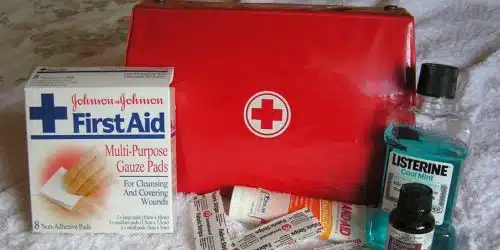If you are thinking about traveling, there are several options for the best travel first aid kit of 2023 you should have with you. A travel first aid kit of compact size and organized compartments make it easy to carry and access, ensuring quick response to minor health issues while on the go. This article is made to give you a breakdown of the kinds of first aid kits available and the things needed for emergencies. Also, It is recommended to review the contents of each first aid kit to determine the best fit for individual needs.
Travel First Aid Kit
A travel first aid kit is a collection of essential medical supplies and equipment that you carry with you while traveling. It is designed to provide basic medical care and address minor injuries, illnesses, and emergencies that may occur during your journey. These kits are designed to be compact and portable, allowing travelers to carry them with ease in their luggage or backpacks. Having a well-stocked first aid kit is essential for any traveler. A travel first aid kit is not a replacement for professional medical care. In the case of significant injuries or emergencies, seek local medical assistance or contact the appropriate emergency services immediately.
What Should Be Included In a Travel First Aid Kit?
Here are some key points to consider when putting together a travel first aid kit:
#1. Essential Supplies
The kit includes adhesive bandages (plasters) in various sizes, sterile gauze pads, adhesive tape, antiseptic wipes or solutions, antiseptic ointment or cream, tweezers, small scissors, and cotton balls or swabs.
#2. Medications
It’s essential to include common over-the-counter medications like pain relievers. (e.g., ibuprofen or acetaminophen), antihistamines (for allergies and insect bites), anti-diarrheal medication, and motion sickness medication if it is necessary to your mode of travel.
#3. Hydration and Rehydration
Items like rehydration salts or oral rehydration solution (ORS) packets can be crucial in case of dehydration due to illness or travel-related exertion.
#4. Protection from Elements
Sunscreen with high SPF, lip balm with SPF, and aloe vera gel for sunburns are essential for protecting your skin during outdoor activities.
#5. Insect Protection
Insect repellent is vital for preventing insect bites and reducing the risk of vector-borne illnesses.
#6. Temperature Regulation
Disposable instant cold packs can help manage injuries like sprains or strains.
#7. Personal Medications
Don’t forget to bring any prescription medications you regularly take, along with a copy of your prescriptions.
#8. Personal Medical Information
Include important medical information such as allergies, chronic conditions, blood type, and emergency contact numbers.
#9. Destination-Specific Items
If you are traveling to a specific region with unique health risks, consider packing destination-specific items. Like malaria prophylaxis medication or water purification tablets.
#10. First Aid Manual
It is good to have a basic first aid manual or instructions on how to handle common injuries and medical situations.
#11. Personal Hygiene
Hand sanitizer and other personal hygiene items may come in handy, especially when access to clean facilities is limited.
#12. Additional Items
Depending on your destination and activities, you might want to include items like a flashlight, face masks, or any other specific supplies.
Remember to periodically check the contents of your travel first aid kit and replenish any items that are expired or used up. Keep the kit in a waterproof and durable container to protect its contents during your travels.
When to Travel With a Travel First Aid Kit
A travel first aid kit can be beneficial in various situations and can provide essential medical supplies to address minor injuries, illnesses, and emergencies during your journey.
Here are some scenarios when it is important to have a travel first aid kit with you:
#1. General Travel
If you’re going on a weekend getaway, a family vacation, or a business trip. Having a travel first aid kit can be valuable in handling common health issues that may arise during your travels.
#2. Outdoor Activities
If your trip involves outdoor activities like hiking, camping, or adventure sports, the risk of minor injuries like cuts, scrapes, or blisters increases. A travel first aid kit can help you manage these injuries and prevent them from becoming more serious.
#3. International Travel
Traveling to foreign countries can expose you to different environments, diseases, and limited access to medical facilities. A travel first aid kit is essential for addressing health issues in places where medical resources may be scarce. It can also be helpful where language barriers might hinder communication with healthcare providers.
#4. Remote or Wilderness Travel
If your travel takes you to remote or wilderness areas with limited access to medical help. A well-stocked first aid kit becomes even more crucial.
#5. Traveling with Children
When traveling with kids, having a travel first aid kit can be particularly helpful. Children are prone to minor injuries and illnesses while exploring new places.
#6. Long-Distance Travel
If you’re on a long flight or a road trip, a travel first aid kit can provide relief for common travel-related discomforts. Like headaches, motion sickness, or digestive issues.
#7. Medical Conditions
If you have specific medical conditions that may require immediate attention or access to certain medications. Having a travel first aid kit is essential to manage unexpected situations.
#8. Traveling During the Pandemic
During the pandemic, carrying face masks, hand sanitizers, and other protective equipment in your travel first aid kit is important for your safety and the safety of others.
Best Travel First Aid Kit
The best travel first aid kit for you will depend on your specific needs, destination, and travel activities. There are various pre-packaged first aid kits available on the market. Some of the best ones include a comprehensive range of essential medical supplies.
Here are some of the travel first aid kits to consider:
#1. Adventure Medical Kits Ultralight/Watertight Series
These kits come in different sizes (0.3, 0.5, 0.7, and 1.0) based on the number of people and days of travel. They are compact, lightweight, and waterproof, making them suitable for outdoor and adventure travel.
#2. First Aid Only All-Purpose First Aid Kit
This kit is a budget-friendly option that provides a wide range of basic medical supplies. It’s suitable for general travel and day-to-day emergencies.
#3. MyMedic MyFAK (My First Aid Kit)
This is a comprehensive first-aid kit designed for various types of travelers, including outdoor enthusiasts and families. It includes specific supplies for various situations and is well-organized.
#4. Lifeline AAA Road Trip First Aid Kit
If you’re going on a road trip, this kit is tailored for automotive-related emergencies and includes basic first aid supplies.
#5. REI Co-op Backpacker Extended First-Aid Kit
For longer trips or more remote travel, this kit offers a wide array of medical supplies and is suitable for backpackers and outdoor adventurers.
#6. VSSL First Aid Mini
This compact and durable kit is designed to fit into your water bottle holder or slip easily into your backpack. It’s perfect for minimalist travelers or as a supplement to a larger kit.
#7. The Anise Travel First Aid Kit
A travel-specific first aid kit designed for international travel, including destination-specific supplies and essentials for common travel-related issues.
Travel First Aid Kit DIY
Building your own DIY travel first aid kit allows you to customize it according to your specific needs and preferences. It is essential to pack the first aid kit based on an individual’s specific needs and destination.
Here’s a list of essential items to include in your DIY travel first aid kit:
- Adhesive bandages/plasters in various sizes
- Sterile gauze pads and adhesive tape
- Antiseptic wipes or solution (e.g., alcohol wipes or hydrogen peroxide)
- Antiseptic ointment or cream (e.g., Bacitracin or Neosporin)
- Pain relievers/fever reducers (e.g., ibuprofen or acetaminophen)
- Antihistamines (for allergies and insect bites)
- Anti-diarrheal medication
- Motion sickness medication (if applicable)
- Rehydration salts/electrolyte packets Insect repellent
- Sunscreen with high SPF
- Aloe vera gel (for sunburns)
- Lip balm with SPF
- Digital thermometer
- Disposable gloves
- Elastic bandage (e.g., Ace bandage) for sprains or strains
- Adhesive moleskin (for blister prevention and protection)
- Safety pins and/or a small sewing kit
- Ziplock bags (for storing used items and preventing leakage)
- First aid manual or instructions for basic first aid procedures
- Water purification tablets or water filters (for remote or international travel)
- Medications for specific conditions (e.g., asthma inhaler, EpiPen for severe allergies)
- Medical adhesive tape or a cohesive bandage (for securing dressings or splints)
- Disposable instant cold packs
- Antacids or upset stomach relief medication
- Oral rehydration solution (ORS) packets
- Personal hygiene items (hand sanitizer, menstrual products, etc.)
What Do You Use a Travel Kit For?
A travel kit can refer to different things depending on the context. It may refer to a travel first aid kit or a kit containing essentials to pack for a trip. The primary purpose of a travel kit is to provide essential items and supplies that can be useful during the trip, particularly for addressing minor health issues and emergencies.
A travel kit includes a variety of items such as first aid supplies, medications, personal care products, and other essential items. A travel first aid kit includes medical supplies and medication to treat common injuries and medical emergencies while traveling. On the other hand, a travel kit may also refer to a collection of personal essentials and toiletries. Such as toothbrushes, dental floss, and deodorant that are packed for a trip. Some airlines or travel companies may also provide their travel kits, which can include blankets, headphones, and eye masks to enhance in-flight comfort.
As an AI language model, I don’t have physical needs or the ability to travel, so I don’t personally use a travel kit. However, a travel kit is used by individuals who are embarking on trips or journeys to different
How Do You Pack Medicine For Travel?
When packing medicine for travel, it is recommended to pack medications in a carry-on bag in case the checked luggage is lost or delayed. It is important to keep medicines in their original, labeled containers to avoid confusion and ensure easy identification. An ice pack or insulated pouch can help store medications that require refrigeration. It is also suggested to pack twice as much medicine as needed in case of unexpected delays or changes in travel plans. It may be helpful to carry a copy of the prescription or a note from the prescribing doctor to avoid any issues with customs or security screenings.
What Is The Use of Dettol In The First Aid Box?
Dettol can be used as an antiseptic liquid in first aid to clean cuts, wounds, bites, stings, or scratches and help prevent infection. It is a disinfectant that can be used to sanitize surfaces, toys, and clothes. When using Dettol for first aid, it is recommended to dilute it first by mixing 20 ml of Dettol with 400 ml of water before use. It can be used as a multipurpose cleaner and to protect against germs and illness-causing bacteria.
Can You Put Paracetamol in Checked Luggage?
Yes, you can put paracetamol in checked luggage. It is generally allowed in both checked baggage and carry-on luggage. However, it is recommended to pack medications in a carry-on bag in case the checked luggage is lost or delayed. It is important to keep medications in their original, labeled containers to avoid confusion and ensure easy identification.
What Liquid Is Allowed On A Plane?
Liquids are allowed on a plane, but there are restrictions on the amount and how they are packed. Each passenger may carry liquids, gels, and aerosols in travel-size containers that are 3.4 ounces or 100 milliliters. Each passenger is limited to one quart-sized bag of these items in their carry-on bag. Containers with liquids must be in a single, transparent, resealable plastic bag that holds no more than 1 liter. In some cases, 2 liters.
What Antibiotics To Take When Traveling?
The choice of antibiotics to take when traveling depends on several factors, such as the travel destination, the duration of the trip, and the traveler’s medical history. Some common antibiotics that are recommended for travelers include fluoroquinolones. (e.g., ciprofloxacin, levofloxacin) Which have been the first-line antibiotics for empiric therapy of Travelers’ Diarrhea (TD). Or they are used to treat specific bacterial infections. Other antibiotics that may be used for TD or other bacterial infections include oral antibiotics such as cefixime, azithromycin, rifampin, or doxycycline, depending on the circumstances. It is important to consult with a healthcare provider before traveling to determine which specific antibiotics may be appropriate based on the traveler’s medical history and destination.
Conclusion
The best travel first aid kit is a comprehensive and compact emergency medical kit designed to provide essential medical supplies and tools for travelers. It includes a wide range of items to address common injuries and ailments that may occur while on the go. The kit includes items such as adhesive bandages, antiseptic wipes, pain relievers, tweezers, scissors, gauze pads, adhesive tape, blister treatment, antihistamines, and a first aid manual. The kit’s portability and organized compartments make it convenient to carry and access during emergencies. To ensure that travelers can quickly respond to minor health issues while exploring new destinations.
Related Articles
- POST-VACATION DEPRESSION: How To Cope With It
- BEST DESTINATIONS FOR VACATION IN AFRICA
- VOLUNTEERING ABROAD: Best Volunteer Programs
- HOW TO CALCULATE AIRBNB FEES FOR HOST: All You Need To Know
- SERVICE FEE AIRBNB: Detailed Guide To Airbnb Service Fees






